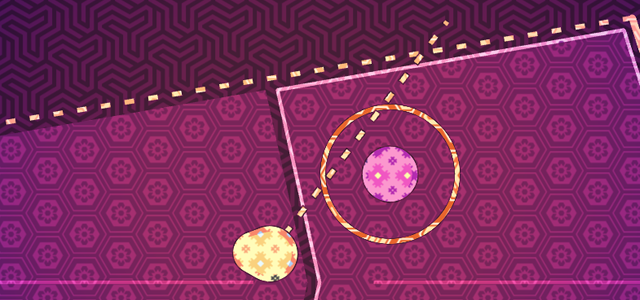JUMP TO
Introduction / Fundamentals / Dash / Cut / Wind / Ghost / Shoot / Poke / Nest / Pulse / Leech / Stim / Corp
PREVIOUS: Dash
CUT
A slow moving class, Cut generally wants to trade time for risk,
and thrives on controlling space.
Depending on your distance from the other player, Cut's initialization
(when it drops its "anchor") will vary in length. If directly beside
the opponent, laying your anchor costs a significant reduction in
momentum and movement speed for several frames. If distant, however,
there is virtually no cost to dropping the cutline anchor.
Bear in mind, the distance you move from your anchor point inversely
affects your speed. The further you move, the slower you move, and the
closer, the faster. While an overall slight effect, it cannot be
totally ignored.

As Cut, you should not necessarily aim to turn over possession of the
ball with your cutline every time. Instead, think of Cut as a tool for
shepherding. When drawing a cutline you will move, at most, an equal
speed to a player who has just picked up the ball. Your anchor, however,
is stationary. Therefore, the speed any given point along your cutline
moves correlates linearly to its distance between you and the anchor.
That is to say, the majority of your cutline will always move much slower
than the defender. You cannot simply drop anchor, expect to catch up to
them and take the ball for free. An effective cutline requires cleverness.
My first advice is to never drop your anchor in the middle of open space.
It should be placed beside a wall or another cutline, giving yourself a
surface to squeeze the opponent against. If you place it in open space,
the opponent can simply run toward your anchor, circling it indefinitely.
When anchored beside a wall, however, the opponent cannot bypass your
cutline, creating an inescapable "checkmate" situation.

Now, a good opponent will foresee these checkmates and know to avoid
them. There is no good way to hide your intentions when attempting to
catch your opponent in such a checkmate, so it is in the opponent’s
favor to move to a place where you cannot trap them. This allows you
to essentially mark whole sections of the level as "off-limits" to the
other player. The benefit of this may not be immediately obvious, but
consider the effects of your opponent scoring one zone's worth of points
in one zone versus the same amount spread across two zones. In the former
situation, you've lost a zone, and potentially the match, but in the
latter each of these zones remain available for your capture. Cut allows
you to dissipate the point accumulation of your opponent while
concentrating your own.
Cut also increases in power toward the end of games on maps with an odd
number of zones. In the case of both players capturing two zones and
fighting over the single final zone, Cut should have an advantage.
Checkmates become vastly more threatening in the final zone, given that
there is no longer any place to which the opponent may retreat.
NEXT: Wind